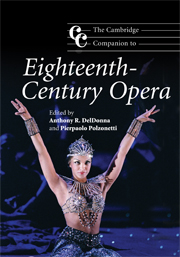Book contents
- Frontmatter
- Part I The making of opera
- Part II National styles and genres
- 9 Genre and form in French opera
- 10 Genre and form in German opera
- 11 Opera in eighteenth-century England: English opera, masques, ballad operas
- 12 Opera in Naples
- 13 Portugal and Brazil
- 14 Opera, genre, and context in Spain and its American colonies
- Notes
- Bibliography
- Index
12 - Opera in Naples
from Part II - National styles and genres
Published online by Cambridge University Press: 28 September 2011
- Frontmatter
- Part I The making of opera
- Part II National styles and genres
- 9 Genre and form in French opera
- 10 Genre and form in German opera
- 11 Opera in eighteenth-century England: English opera, masques, ballad operas
- 12 Opera in Naples
- 13 Portugal and Brazil
- 14 Opera, genre, and context in Spain and its American colonies
- Notes
- Bibliography
- Index
Summary
Introduction
Opera in Naples has often been characterized in convenient historiographic terminology such as “Neapolitan opera,” which was the result of a “Neapolitan school” of musicians. These descriptions encourage, however, a narrow interpretation, which has obscured the broad significance of opera practices in Naples. In particular, they posit the suggestion of opera in Naples as limited to local traditions and the locus of their creation rather than recognize the highly innovative stylistic phenomenon at the national level in the Italian states. Opera in eighteenth-century Naples, similar to Viennese Classicism (as espoused by Haydn and Mozart at the end of the century) was the fullest expression of a cultural matrix of creators, practitioners, theorists, patrons, and entrepreneurs (whether aristocratic, public, or sacred), which not only benefited from prodigious local talent, but also the dense nexus of theatrical establishments, conservatories, and culture at large. The cumulative effect of such an artistic environment was to establish operatic styles (whether seria or buffa) that reflected local practices and also established an international presence of significant importance for the eighteenth century. This phenomenon was verified not only by the gravitation of non-native artists to Naples, a European cultural epicenter, to assimilate, perhaps even learn the latest conventions, but also by the considerable international dissemination and acceptance of a Neapolitan repertory in Italian and European practices. This chapter addresses the history of opera in Naples, focusing on how local genres were both typical in the context of the eighteenth century and also highly idiosyncratic to the city, which together helped to distinguish the Neapolitan repertory within contemporary traditions.
- Type
- Chapter
- Information
- The Cambridge Companion to Eighteenth-Century Opera , pp. 214 - 232Publisher: Cambridge University PressPrint publication year: 2009

